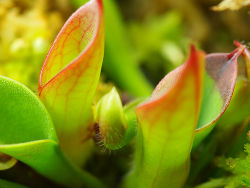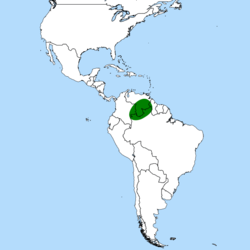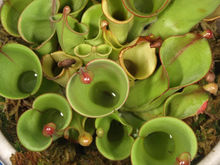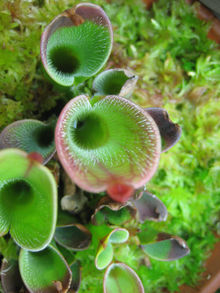Sun pitcher
| Sun pitcher |
|---|

|
| Scientific Classification |
|
| Species |
|
| Distribution of Sun pitchers |
Sun Pitchers are carnivorous pitcherplants belonging to the taxonomic genus Heliamphora. They are an excellent example of the ingenuity with which God made earth and all it's living things. It is one of only a few plants that are carnivorous making it very unique in the plant kingdom.
Body Design
Sun pitchers have stiff bodies and can hold their own against the strong winds of the flat-topped mountains. They are, however, brittle and are easily damaged when handled improperly.
Most sun pitcher leaves are green, but some are red. Even the sun pitchers with green leaves have read veins, leaf margins, and other parts. The leaves grow from the innermost part of the plant.
Sun pitcher flower stalks produce several flowers that open one at a time during a period of several weeks. They do not have true petals, but only sepals, which are the parts of the flower which would normally enclose and protect the petals (if there were any). [3]
Life Cycle
The sun pitcher can reproduce either sexually or asexually.
Sexual reproduction in sun pitchers occurs when one produces pollen, and the pollen is transferred to the ovaries of Sun pitcher. Then a seed is formed, which mixes the genes from the pollen and the egg in the ovary. This method of reproduction creates a plant with characteristics of both parents. Even if the plant self-pollinates its chromosomes are recombined.
Asexual reproduction can occur when a piece of stem breaks off or comes in contact with the soil. New roots form from the bud area of the stem and new leaves emerge creating a new plant. They can also reproduce asexually through tubers and roots. [4]
Ecology
The majority of sun pitchers live on the plateaus of the flat-top mountains (tepuis) in Guyana, Venezuela and Brazil.
The native environment of the sun pitcher is tropical, as it is close to the equator, and cool because it is at a high altitude. The savannas around the tepuis are at least 4000 feet above sea level
The high altitude is suited for the sun pitcher, because all the plants that it shares its space with are not too big or tall, so it can receive sufficient sunlight.
The pitcher plant will eat any insect. If the pitcher plant is large enough it can and will digest bigger animals like mice, amphibians, and other small animals. [5]
Diet
Sun pitchers have a "nectar spoon" which makes a sweet smelling liquid that insects are attracted too. They also have downward-pointing hairs on the inside.
Insects will try to eat the liquid, but they will often fall inside the plant. They are unable to climb out because of the downward-pointing hairs and eventually drown and become digested. [6]
Video
A man showing his Sun pitcher plants
References
- ↑ Sarraceniaceae USDA Plants Database. Web. Accessed July 7, 2013.
- ↑ Heliamphora Wikispecies. Web. Date-of-publication(April 5 2011).
- ↑ D, Steve. Heliamphora FlyTrapCare. Web. Date-of-publication 16 January 2010.
- ↑ Rose, Kasandra. Do Pitcher Plants Reproduce Asexually or Sexually? eHow. Web. Date-of-access (5/27/2013).
- ↑ D, Steve. Heliamphora FlyTrapCare. Web. Date-of-publication 16 January 2010.
- ↑ Daniels, Donna. The Pitcher Plant Eats Insects and Bugs Yahoo. Web. Date-of-publication (April 30, 2009).



